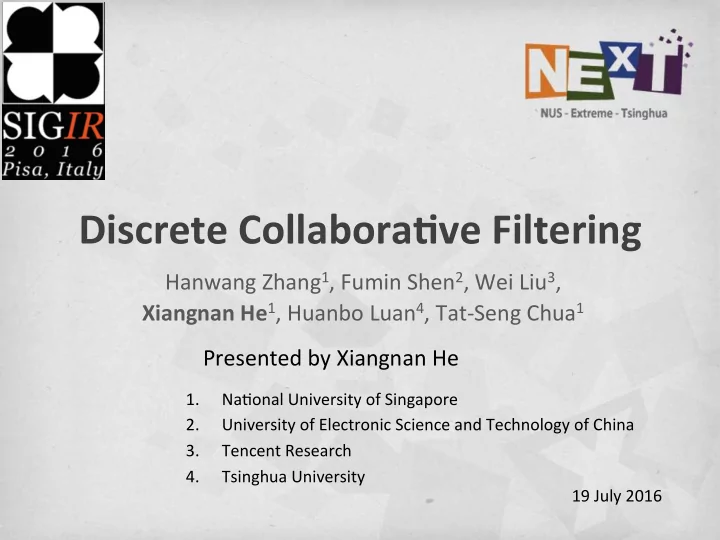

Discrete Collabora.ve Filtering Hanwang Zhang 1 , Fumin Shen 2 , Wei Liu 3 , Xiangnan He 1 , Huanbo Luan 4 , Tat-Seng Chua 1 Presented by Xiangnan He 1. Na>onal University of Singapore 2. University of Electronic Science and Technology of China 3. Tencent Research 4. Tsinghua University 19 July 2016
Online Recommenda-on • An Efficient Recommender System • Latent Model: Binary Representa>on for Users and Items • Recommenda>on as Search with Binary Codes Offline Training • End-to-end binary op>miza>on • Balanced and Decorrelated Constraint • Small SVD + Discrete Coordinate Descent 2
Latent Factor Approach [Koren et al. 2009] User-Item Matrix Latent Space 3
Recommenda>on is Search Ranking by <user vector, item vector> Search in Euclidean space is slow Requires float opera>ons & linear scan of the data Search in Hamming Space is fast. Only requires XOR opera>on & constant-.me lookup User-Item Database Hash Table Query Code 4
[Zhang et al, SIGIR’14; Zhou et al, KDD’12] • Stage 1: Relaxed Real-Valued Problem {B, D} ß Con-nuous CF Methods • Stage 2: Binariza>on B ß sgn (B), D ß sgn (D) Code learning and CF are isolated Quan-za-on Loss 5
1. A,B , a,b are close but they are separated into different quadrants 2. C, d should be far but they are assigned to the same quadrant 6
7
Observed ra>ng User code Item code Binary Constraint Ra>ng Predic>on However, it may lead to non-informa>ve codes, e.g.: 1. Unbalanced Codes à each bit should have split the dataset evenly 2. Correlated Codes à each bit should be as independent as possible 8
Illustra>on of the effec>veness of the two constraints in DCF Balanced: Decorrelated: Without any constraints: Separated in the Well separated 3 points are (-1, -1) and 1 1 st & 3 rd quadrant point is (+1, -1), which is not discrimina>ve. 9
However, the hard constraints of zero-mean and orthogonality may not be sa>sfied in Hamming space! 10
Objec>ve func>on: Constraint Trade-off Ra>ng Predic>on Binary Constraint Decorrelated Constraint Balanced Constraint Delegate Code Quality Constraint Mixed-Integer Programming NP-Hard [Hastad 2001] 11
Alterna>ve Procedure • B-Subproblem • D-Subproblem • X-Subproblem • Y-Subproblem 12
Objec.ve Func.on For each user code b i , op>mize bit by bit Parallel for loop over m users Usually converges in 5 itera>ons for loop over r bits D-Subproblem can be solved in a similar way 13
#bits #bit-by-bit itera>ons #compu>ng threads #training ra>ngs Linear to data size! 14
Objec.ve Func.on r x m row-centered user code matrix Small SVD r x m Orthogonaliza>on Y-Subproblem can be solved in a similar way 15
#bits #users Linear to data size! 16
• Recommenda>on is search • We can accelerate search by hashing • Unlike previous erroneous two-stage hashing, DCF is an end-to-end hashing method • Fast O(n) discrete op-miza-on for DCF 17
• Dataset (filtering threshold at 10) : • Random split: 50% training and 50% tes>ng. • Metric: NDCG@K • Search Protocol: Hamming ranking or hash table lookup 18
• MF: M atrix F actoriza>on [Koren et al 2009] Classific MF, Euclidean space baseline • BCCF: B inary C ode learning for C ollabora>ve F iltering [Zhou&Zha, KDD 2012] MF+balance+binariza6on • PPH: P reference P reserving H ashing [Zhang et al. SIGIR 2014] Cosine MF + norm&phase binariza6on • CH: C ollabora>ve H ashing [Liu et al. CVPR 2014] Full SVD MF + balance + binariza6on 19
Performance of NDCG@10. 1. DCF learns compact and informa>ve codes. 2. DCF’s performance is most close to the real-valued MF. 3. End-to-end > Two stage 20
Training: full histories of 50% users Tes>ng: the other 50% users that have no histories in training Evalua>on: simulate online learning scenario. 21
MF: original MF MFB: MF+Binariza>on DCFinit: the variant of DCF that discards the two constraints. 22
• D iscrete C ollabora>ve F iltering: an end-to-end hashing method for efficient CF • A fast algorithm for DCF • DCF is a general framework. It can be extended to any popular CF variants, such as SVD++ and factoriza>on machines. 23
Code available: hups://github.com/hanwangzhang/Discrete-Collabora>ve-Filtering 24
Recommend
More recommend